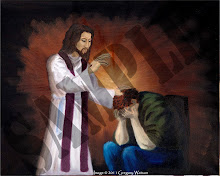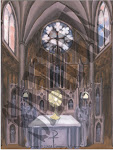Having arrived in Beau-Sejour, we were warmly welcomed with a wonderful meal of Creole cooking: fried chicken, plantain chips, caseroles of corn, potato, beets, peas, and other good things, and ice cold Coca-Cola, and beer. Everything was fantastic! Well, except the beer. They gave us Colt .45, which is American beer. It wasn't until later that they unleashed their award-winning "Prestige" Haitian beer--which was wonderful! I guess they were worried we wouldn't be able to handle it! After our welcoming lunch, our exhausted troupe took a siesta to recover from our long climb and proceeded to unpack.Beau-Sejour is a remote mountain community. "Village" would be almost too generous a term. Throughout the mountains there are little huts and "gardens" that are almost like vertical farms, planted down the side of the mountain. All around are gorgeous vistas and Edenic scenery. The poverty of the residents of Beau-Sejour isn't like the poverty of homeless beggars in the inner city. These people are "poor" in the sense that they don't have running water, or proper toilets, or cable television. But they have food, if not in gluttonous abundance, and they have shelter. In fact, thanks in part to our parish's help, everyone's home had been rebuilt, except for Père Ronal's rectory and the Church itself, as well as the various schools. Père Ronal's rectory was under construction when we arrived. I'll talk more about the Church in my next chapter.
The strangest sight, I think, were the cell phones. It seemed everyone had a cell phone, and the Haitians are very proud of them. People would be walking around without shoes, but they had a cell phone. I suppose everyone needs their toys, and a cell phone would be a particularly useful thing in a remote mountain community where your closest neighbour might otherwise be an hour's walk. Nevertheless, it was often a startling juxtaposition.
Fr. Bill and Nassrin, being the priest and the only woman on the trip, were afforded relatively comfortable lodgings in Père Ronal's temporary rectory, while Dan, Mark, Michael our translator, and myself slept in a very large tent out behind the Church. This location did afford us close proximity to the one structure that our church helped build in Beau-Sejour that was not damaged in the earthquake: the washroom. I said earlier that the people of Beau-Sejour don't have running water--at least, not plumbing in the conventional North American sense. They trap rainwater in large reservoirs which also act as filters, and are tapped. Water is then carried to wherever it is needed. Carried, on the heads of the people! That itself is a sight to see: an elderly woman carrying a gallon of water on her head, without spilling, over rocky terrain, without adequate footwear, as if the water hardly weighed more than a couple pounds! When us young, strapping men had to carry our own water, on occasion, holding the buckets by their handles, and trying to nearly drag them up the hill from the reservoir to the bigger barrel outside the washroom, I can only imagine what was going through the minds of the locals! «Les blancs sont foux!»
The larger barrel, into which we dumped the water carried by us with such indignity, and by the Haitians with such grace, was used for washing and for flushing the toilet. One had to dump a pail of water into the toilet after its use to flush the contents down a pipe and out down the mountainside. It also wetted our toothbrushes, and theoretically, at least, was used to "shower", or, at least, to dump on top of us in lieu of showering. However, this didn't happen as such, at least not for the guys. Turns out, it rains every afternoon, and by rain, I mean, that being up in the mountains, the clouds rolled in around you, and then sort of "erupted" right above your heads. So it provided a nice effective shower!
When one enters "downtown" Beau-Sejour, after passing a few homes just outside of town, one enters into something of an archway and a low wall--at least, we entered the remains thereof--into a patch of level ground. It's more or less the highest point of "Beau-Sejour" proper, and as such, the Church is there at the back end of this level area. Well, what's left of St. Gabriel, anyway--bamboo posts holding up a large tin roof with some metal posts on the interior, and tarps strung up as "walls". Out behind the church, as I mentioned, was our tent and the washroom. The level area drops off sharply just beyond our tent with a wall of sorts, and right below was the framework of Père Ronal's new rectory. Out front of the Church, on the other end of this level area, was the clinic that St. Margaret Mary parish had helped to build, and which housed the medical and dental mission teams that we sent down. The earthquake, however, had entirely destroyed this building, and what was still standing was doing so quite precariously. Between the old clinic and the remains of the Church is a downward sloping hill of loose rock and earth, about four or five people wide, surrounded by banana trees and other thick vegetation (all around us was "jungle" it seemed). At the bottom of the hill was Père Ronal's current home, with his housekeeper and family, and the nurse from Léogane who tried to look after the needs of the people. It acted as a bit of a hub for the community. On the other side of the lane was the "Boutique", which was a sort of general store from which you could buy chips, candy, beer, and anything else you needed, which the proprietor "imported" from Léogane or Port-au-Prince. It too was the centre of life for the residents of Beau-Sejour. Further down the lane were more homes, and well off on the opposite hillside were the Petit Frères de Ste. Thérèse, whom I mentioned in a previous chapter. Surrounding all of this were steep slopes into luscious valleys, which would have been even more lush had they not been stripped of their trees. As it is, they're fighting to produce vegetation again despite the soil erosion caused by the denuding. In spite of this environmental reality, Beau-Sejour is a beautiful place.
As I mentioned, our purpose for going was ostensibly to teach First Aid. I say "ostensibly" because only Nassrin was actually equipped to teach it (and it's probably something of a stretch to suggest that anyone else on the team even knows First Aid!) So while Nassrin was able to get down to business, working out with Père Ronal the hows and the whos of the rest of the week, and began teaching on Saturday morning, Fr. Bill, Dan, Mark, and I were left wondering just what it was that we were supposed to do. We couldn't help teach First Aid. We weren't construction workers. We couldn't help build Père Ronal's rectory. We didn't have proper equipment to help demolish the damaged clinic and other buildings. To make matters worse, our translator, Michael, was helping Nassrin teach, so we could hardly even communicate!
I was discussing our dilemma with Fr. Bill, and I said, "I don't even know what I'm doing here anymore. What do I have to contribute? Nassrin is teaching First Aid. What do I do? I draw pictures!" Fr. Bill stopped and said, without missing a beat, "Why don't you do that?" I replied, "That counts as 'doing something'?" Father simply answered, "Why not?" He'd hit on the real reason we'd come--not to teach First Aid or to build buildings, but primarily to build relationships--and he saw my art as one very good means of doing so. So I ran back to the tent and got my sketchpad, and moseyed down to the Boutique, pulled up a chair across from the few villagers lounging under the veranda out front, and began to draw them. This, of course, drew their attention, and they tried to figure out just what I was doing. A few walked over to see my work, and started laughing and pointing (which is always good for one's self-esteem, when someone laughs at you in another language!) I understand people enough, thankfully, to know that they weren't laughing at me, but with joyous wonder, saying "Look! That looks just like Tijor!" Once everyone had caught on, they began asking me to draw specific people's portraits, of which I had time and opportunity to draw two (after all, despite their desire to be drawn, their desire to sit still and let me draw them was significantly diminished). So I drew the portraits of a lovely woman named Anite, and her daughter L'ovlis, which is actually pronounced "lovely". This was on top of the initial sketch of the Boutique's veranda, seated in which were old Tijor, already mentioned, as well as two youths, Willie and Pierre-Renaud, who eagerly inscribed their names (and ages) beside their likenesses. While I gave Anite's and L'ovlis' portraits to them, I kept this initial sketch of Tijor, Willie, and Pierre-Renaud as a souvenir of my own. It was, after all, the thing that I could do, which broke the language barrier and made us even more than family--it made us friends. And that friendship led to other wonderful events later on in our stay. But for those stories, you, dear reader, will have to wait.
We've gotten through Saturday so far. Up next, Sunday and Mass in Haiti! After which followed perhaps the scariest part of our journey, and, for some of us, our lives. Stay tuned!







